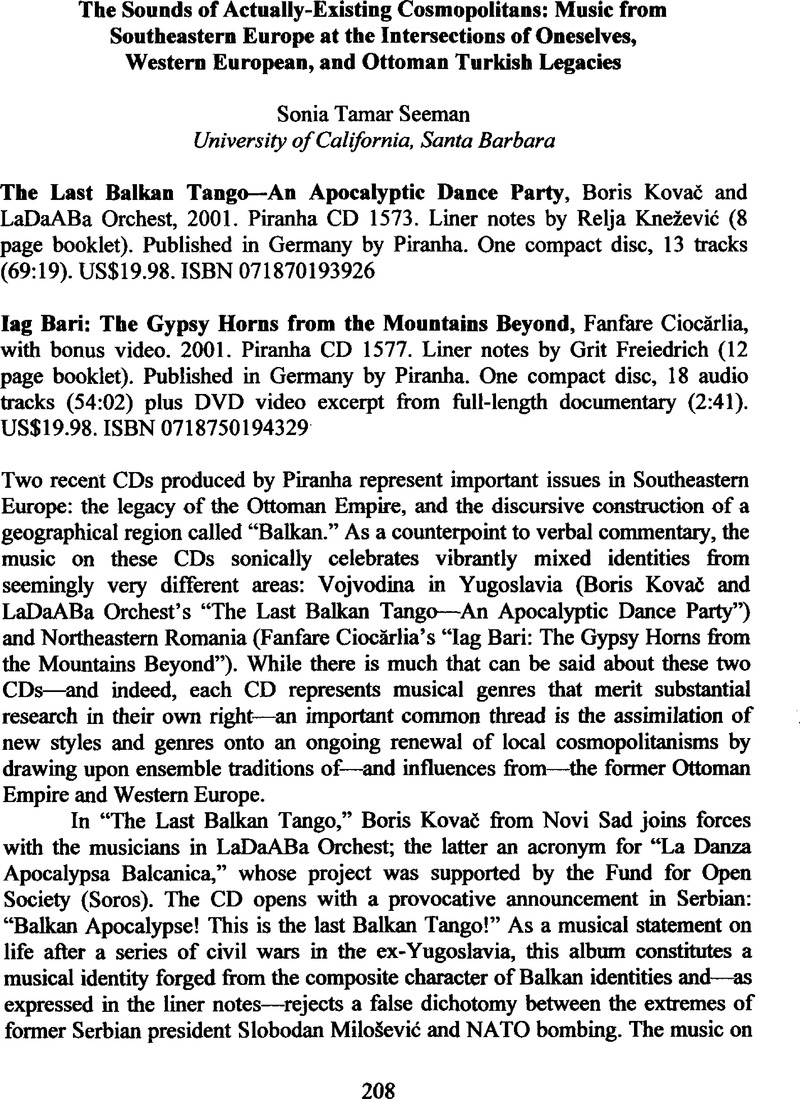No CrossRef data available.
Published online by Cambridge University Press: 09 March 2016

1 “Thus in the music of LaDaABa orchest,” a mixture of tango, folk dance and Secession, waltz and burek…carousing, suffering, and wit, laughter, tears, sacrifice, and surrender, Dionysian drunkenness and vulgar primitivism, on the millennial edge, and for the sake of the promising moment of happiness, “The Last Balkan Tango” dances again—FOR DANCING, NOT LIVING, IS WHAT MATTERS TO US‘” (caps in original text), p. 5.
2 The mehter military bands accompanied the Ottoman yeniçeri (“janissary”) soldiers into battle, and were established at the outposts of newly-conquered Ottoman territories as a sonic symbol of Ottoman conquest. Supported by the court, these ensembles also performed at state functions and celebrations, as well as playing music to greet foreign officials. (Cf. Sanal, Haydar. 1964. Mehter Musikisi: Bestekâr Mehterler – Mehter Havalar1. Istanbul: Milli Eğitim Basimevi; Walter Feldman. 1991.Google Scholar “Mehter,” The Encyclopaedia of Islam, New Edition, Leiden: E. J. Brill.) Military ensembles in Southeastern Europe further intermixed Western European band traditions with those of the Ottoman mehter ensemble in the borderlands between the Ottoman and Habsburg Empires. (Cf. Kos, Koraljka. 1998. “East and West in Military Music on the Ottoman-Habsburg Border,” in Music, Politics, and War: Views from Croatia, Pettan, Svanibor, ed. Zagreb: Institute of Ethnology and Folklore Research.)Google Scholar
3 Ottoman Sultan Fatih Mehmet annexed Wallachia in 1462; Sultan Kanuni Suleyman annexed Moldavia in 1538. It was not until 1878 that Moldavia and Wallachia achieved independence.
4 Rom professional musicians of various ensemble types continue to synthesize Ottoman musical features with local rural and urban genres. For an example that explores the implications of Ottoman influence on urban Romanian Roma musical practice, see Garfias, Robert. 1981. “Survivals of Turkish Characteristics in Romanian Lautareasca,” Yearbook for Traditional Music 13: 97–107.CrossRefGoogle Scholar In 1989, a Romanian Roma violinist informed me he had performed at a Romanian Roma wedding in the 1980s in which the family had hired an ensemble from Turkey. According to him, upper class urban Romanian Roma prefer Turkish Roma ensembles and Turkish-influenced repertoire.
5 This dance meter is variously called čocek, čuček, kjuček in Macedonia, Serbia, and Bulgaria.
6 For insight into contemporary conditions in Romania, I am indebted to UCSB graduate student Ralph Lowi, who conducted field research in Romania during the summer of 2004, and who read over and commented on this portion of the review.
7 Robbins, Bruce. 1998. “Actually Existing Cosmopolitanism,” in Cosmopolitics: Thinking and Feeling beyond the Nation, Cheah, Pheng and Robbins, Bruce, eds. Minneapolis: University of Minnesota Press, pp. 2–3.Google Scholar
8 Rabinow, Paul. 1986. “Representations are Social Facts—Modernity and Post-Modernity in Anthropology,” in Writing Culture: The Poetics and Politics of Ethnography, Clifford, James and Marcus, George, eds. Berkeley: University of California Press, p. 258.Google Scholar